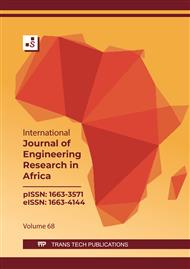p.1
p.11
p.31
p.51
p.67
p.85
p.99
p.117
p.129
Mixture Design Identification of Admissible Tannery Sludge Incorporation in Fired Bricks
Abstract:
Pollution problems caused by industrial production of leather tanneries are an important environmental issue. In the present paper we propose to study effects of tannery sludge (TS) addition in manufactured clay bricks applying a mixture design formed by different proportions of four components: Clay, two types of sand and TS. The analysis leads to an optimal practical mixture of around 10% of TS, 20% of sand and 70% of clay and this to remain with an acceptable aspect, an admissible water absorption below 15%, an admissible total shrinkage (drying and after fire) lower than 8%, a tensile strength higher than 5MPa and a thermal conductivity of 0.93 Wm-1K-1, 15% lower than the reference mixture with 0% of TS. Experimental results indicate that a temperature cycle firing up to 950°C can lead to higher tensile strength and lower water absorption compared to a cycle that reaches only 850°C. Furthermore, incorporating (TS) in the fired brick manufacturing process can lead to significant energy saving. Additionally, it was observed that a moderate inclusion of TS can enhance evaporation process. Keywords : Mixture design, Tannery Sludge (TS); Clay bricks ; Evaporation ; Strength; Water absorption; Shrinkage; Leaching; Energy.
Info:
Periodical:
Pages:
11-30
Citation:
Online since:
April 2024
Authors:
Keywords:
Price:
Сopyright:
© 2024 Trans Tech Publications Ltd. All Rights Reserved
Share:
Citation:


